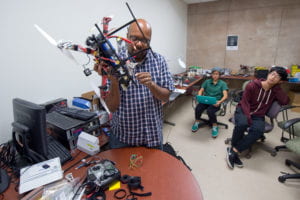Robots to the rescue
UCI competition challenges students to design machines that can search for disaster victims

Sunday, May 22, was an absolutely gorgeous day to be in Aldrich Park on the University of California, Irvine campus. The sun shone brightly, and a pleasant breeze wafted through swaying trees over a lush expanse of grass. The tranquil setting would have been perfect for a picnic, but it was less than ideal for participants in the 2016 UCI Rescue Robotics Invitational.
Even a slight puff of wind can make it difficult for a quadcopter to navigate; light from above interferes with robots’ color sensors; and a soft, lumpy lawn presents traction issues for small wheels. It’s all part of the challenge for Rescue Robotics competitors.
UCI and half a dozen other colleges and high schools from around Orange County took part this year. Their goal was to create robotic systems, either ground-based or aerial, that could traverse a square field autonomously and detect “disaster victims” – in this case 5-gallon orange buckets from the local home improvement store.
When it was over, bragging rights went to a team from Garden Grove’s Santiago High School that fielded an aerial vehicle. Laguna Hills High School came in second with a ground robot, and UCI’s six-wheeled rover took third place. The invitational, in its second year, was coordinated by UCI and Vital Link, an organization that helps local youth find rewarding educational and career opportunities.

With earthquakes, wildfires and mudslides, “the challenge makes sense here in Orange County. When we have a disaster, the standard way of searching for victims is to line up everyone you can get in a row and start moving forward one step at a time,” says faculty adviser Michael McCarthy, a professor of mechanical & aerospace engineering. “If we could have these simple drones that go out and identify where victims are located, it could be faster and much more practical.”
He and his collaborators established the competition with three main requirements: The robots had to function outdoors, compensating for wind, different lighting conditions and varying terrain. They had to be able to operate with multiple units in the field at the same time. And, most importantly, they had to work without being controlled remotely by humans.
“Competitors are not allowed to touch or control the robots once they’re in the field,” says faculty adviser Jeffrey Krichmar, a professor of cognitive sciences. “They can manually get them in place to start, then it’s up to the robots to find the buckets. It’s a big challenge that requires a ton of programming and a lot of skill in designing and building a system to do the job.”
Ground units are usually constructed on a base with six wheels that “scrub steer” the way a tank maneuvers on its treads. Most include a platform for structures to support GPS units, digital cameras and microprocessors that control the trajectory of the vehicle. Many teams use an Android smartphone that bundles these functions together, thanks to clever app programing by the students.
The aerial robots involve a different level of complexity. Instead of a smartphone, the quadcopter drones each employ an Arduino microprocessor to help it buzz through its flight plan, snapping pictures of orange buckets and recording GPS coordinates.
Associate professor of computer science Ian Harris says that in addition to fielding its own teams, UCI serves as a mentoring center for other participating schools.

Steve Zylius / UCI
“Our job is to help them during the course of the year with training on how to build, configure and program quadcopters or ground vehicles,” he says. “We built our own systems in advance to stay ahead and be ready for any questions that might come up.”
UCI ground robot team member Tiffany Hwu, a graduate student in Krichmar’s Cognitive Anteater Robotics Laboratory, says the competition is relevant to her research. “We have a good understanding of how animals represent places in the brain. They have a sense of direction, a sort of dead-reckoning system, and we have models for that,” she says. “It’s not too far of a jump to take these models of navigation and transfer them into robots.”
Orange’s El Modena High School, which sends teams to compete in robot battles around the country, entered two drones and one ground robot in the UCI invitational. Engineering and robotics teacher Mark Bowie says that UCI’s competition is among the most difficult his students have encountered. “Making something that’s going to smash into another robot – that’s easy. Running autonomously and getting all the components to talk to one another is really hard,” he notes.
McCarthy says there’s a payoff for all the hard work and a strong sense of purpose embedded in the process: “If it’s just algorithms to do simple jobs, the students get bored incredibly fast. But if the programming is to do something dramatic like control a drone that’s trying to find people … that changes their whole view. It gives them an opportunity to show off what they’re capable of.”